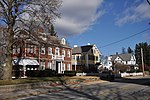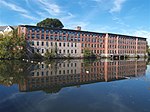Union Village, Rhode Island
Accuracy disputes from June 2022Historic districts on the National Register of Historic Places in Rhode IslandNRHP infobox with nocatNorth Smithfield, Rhode IslandUse mdy dates from July 2023 ... and 3 more
Villages in Providence County, Rhode IslandVillages in Rhode IslandWoonsocket, Rhode Island

Union Village or "Bank Village" is a village and historic district located in North Smithfield and Woonsocket, Rhode Island on Rhode Island Route 146A. Union Village developed because it was at the cross roads of old Great Road (Smithfield Road Historic District) (connecting Providence and Worcester, Massachusetts) and Pound Hill Road (connecting the Blackstone River falls to Chepachet and Connecticut).
Excerpt from the Wikipedia article Union Village, Rhode Island (License: CC BY-SA 3.0, Authors, Images).Union Village, Rhode Island
Pound Hill Road,
Geographical coordinates (GPS) Address Nearby Places Show on map
Geographical coordinates (GPS)
| Latitude | Longitude |
|---|---|
| N 41.991111111111 ° | E -71.536944444444 ° |
Address
Pound Hill Road 29
02896
Rhode Island, United States
Open on Google Maps










